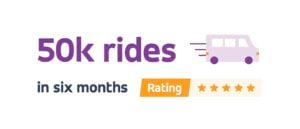Don't miss another podcast. Sign up here.
For most cities around the world, space is at a premium. This couldn’t be more true than in one of the top five most populated cities in Brazil: Fortaleza.
Fortaleza is known for its breathtakingly unique urban space. Think: a sprawling ecological preserve smack dab in the center of town, the city’s entire northern border running along the stunning waters of the Atlantic. These same features that define the beauty of the city restrict the amount of physical space available, thus posing a challenge for transit operators and city officials tasked with providing affordable and high-quality transportation options.
Transit syndicate Sindiônibus, which represents bus companies in Fortaleza and the surrounding metropolitan region, launched the on-demand public transportation service TopBus+ in December of 2019. Using the Top Bus+ app (iOS and Android), riders can request a shared ride from their smartphone and travel anywhere within the city’s 11 service areas, as well as major shopping malls and nearby universities that sit just outside these zones.
“The thing we believe in is collective transportation,” said Dimas Barreira, President of Sindiônibus. “ We saw a trend of on-demand transportation, but we wanted to make it work for shared public transit. We’d been talking about that for three years before we started this service.”
And making on-demand technology work for shared transit is exactly what Sindiônibus aimed for. Barreira highlighted that the new on-demand service gives riders much more freedom, removing the need for private vehicles. “People can use the service in a lot of ways. It can be helpful for anyone who wants a very flexible mode of transportation, which is also friendly to the city’s needs.”
The TopBus+ on-demand service works as a first-and-last mile solution, transporting residents to and from transit stations, while also providing the option for riders to use the service for an entire trip. The move from fixed-routes to a dynamic system that can adapt to changing traffic patterns in Fortaleza’s complex urban geography is also contributing to the new service’s overall success. In fact, since launching in December, TopBus+ has given more than 50,000 rides, with the vast majority of riders rating their experience 5 stars.
 A feature that has Sindiônibus and the operators particularly excited about on-demand is the ability to connect with riders directly through a user-friendly app. As Barreira says, “in public transportation, we’re not used to having one-to-one contact with the customer, and it’s something we can do with the on-demand service.”
A feature that has Sindiônibus and the operators particularly excited about on-demand is the ability to connect with riders directly through a user-friendly app. As Barreira says, “in public transportation, we’re not used to having one-to-one contact with the customer, and it’s something we can do with the on-demand service.”
Not only does this new communication channel foster a deeper relationship with the customer, but these interactions can also inform decision-making. “Through the application, we exchange messages, we receive feedback, and we’re able to listen to this feedback and develop the service.”
One example of such a development came from riders requesting that TopBus+ add the city’s Bilhete Único — an integrated “single ticket” that can be used throughout Fortaleza’s public transportation system — as a payment method. Many city residents receive credit from employers, student discounts, and/or senior citizen discounts on the Bilhete Único and this change enabled these individuals to incorporate TopBus+ into their lives.

Quickly adapting to new realities is possible with flexible on-demand transit.
Within a few months of launching, the on-demand service has rapidly adapted to changing transit priorities as a result of COVID-19. In addition to temporarily switching to a private transportation model and heightening sanitary measures, the pandemic has prompted an expansion of TopBus+. “We had a geographic area in the city that we already knew wanted the on-demand service,” Barreira said. This portion of the city also has hospitals and other healthcare facilities, which ultimately drove the decision to include it in the service area, in order to meet the larger community’s current needs.
Barreira maintains that public transportation must continue to innovate in order to keep pace with a continuously evolving urban environment, and he is confident that services like TopBus+ are the answer. “We have people in regions nowadays that mostly take long rides — they come from faraway regions to downtown,” he noted. “We’re still going to have long rides from those neighborhoods, but also short rides within the neighborhood, and our on-demand service can adapt to that very easily.” Longer term plans include integrating TopBus+ with every other transportation option available in the Fortaleza metro area through one rider-facing mobility as a service (MaaS) platform. In doing so, the city hopes to provide an even more seamless public transit experience.
In the meantime, Sindiônibus is looking forward to expanding the on-demand service. “In the near future, we can see 200 to 300 TopBus+ buses in Fortaleza, and we think it will match the city’s larger public transportation system very well.” Moving beyond the rigid constraints of a traditional bus system and embracing on-demand shared transit is a solution for cities like Fortaleza that must find new ways to efficiently and sustainably take their residents where they need to go.



